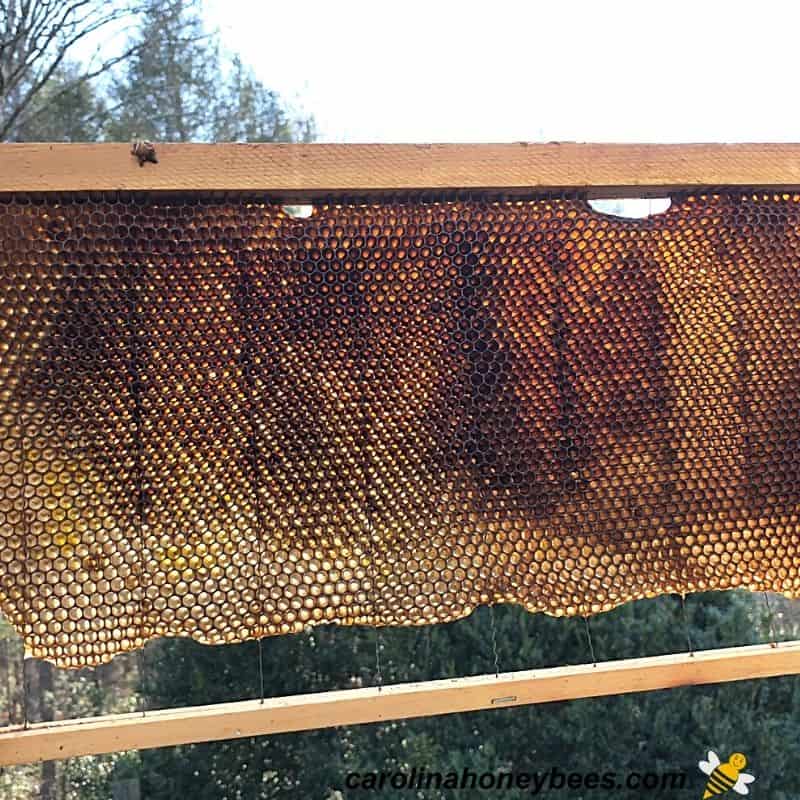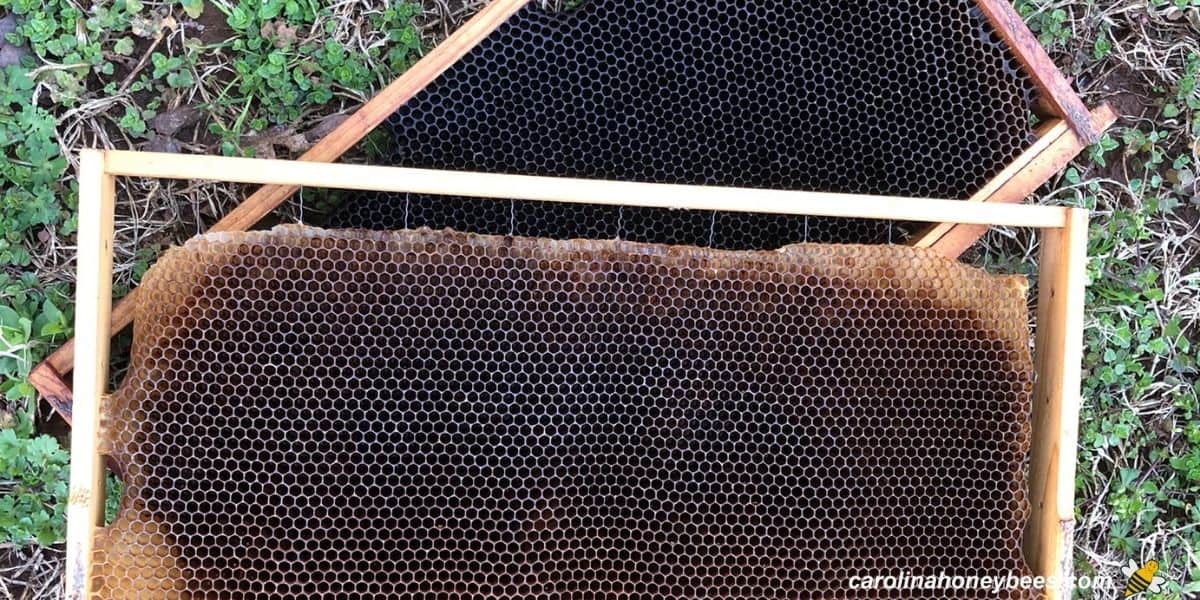Black Honeycomb: What to do With it?
When visions of honeycomb dance through your mind, you likely think of bright golden sheets of wax – not black honeycomb. While new beeswax is actually white, it doesn’t stay that way for long. In fact, if left in your colony for many seasons, you will have very dark comb.

It is only natural that your fresh honeycomb would not stay light with all those little feet tramping about. But, it is not only foot traffic that darkens this natural white wax made by honey bees.
Black Honeycomb in Your Hive – What it Means
Finding very dark or even black honeycomb in a hive can be rather disconcerting to someone new to beekeeping. Thought, it takes a while for beeswax to darken that much.
However, if you purchase nucleus colonies you may receive older comb in the box. Sometimes, it is much older.
In your own apiary, even the most beautiful beeswax sheets will darken as time goes by. Debris, dirt, propolis (bee glue) and just stains from use have a daily affect.
Worker bees have special wax glands on the underside of the body that are capable of producing wax. These white scales of wax are shaped into the comb that we are familiar with.
Virgin honeycomb is a thing of beauty but that does not mean you need to discard it when it gets a bit dark.
However, there will come a time when it is a good idea to refresh your wax. Not just because of the color but because of the factors that cause dark comb.
What Makes Honeycombs Dark?
Dark brown honeycomb occurs most often in the brood nest of the hive. However, even comb used in honey supers can get darker over several years. Debris, stains and other items are absorbed by the beeswax.
- Everyday Bee Activities
- Pupal Cocoons
- Propolis
- Overuse as Brood Comb

Fresh honeycomb is a thing of beauty but the bees don’t make it because it is pretty. (At least as far as we know)! The hexagon shaped cells made by bees are used by the colony constantly.
Every hour of every day, thousands of little feet are padding across the surface of the comb. Do you think they all wipe their feet when they come into the hive? No, they do not.
These thousands of wax cells are used to hold food for the everyday needs of the colony. There are also areas of stored food for Winter survival. Both honey and bee pollen results in some darkening of the honeycomb due to stains.
Brood Nest Comb
However, the area of the hive where young are raised is the quickest to have dark or even black honeycomb. Bee brood require a lot of attention during this growth phase.
Nurse bees make thousands of trips each day to feed the growing bee larvae located in brood cells. All of this foot traffic results in some staining of the beeswax. Finding darker combs in your frames in this area of the hive is natural.

Another aspect of the honey bee life cycle that contributes to comb color changes – pupal cocoons.
During the last stage of development, the bee pupae is inside a capped cell. Sticky pupal cocoons are produced during the transformation to adult. When the young adult bees emerge from their wax cells, these cocoon linings are left behind.
This means that over time, the beeswax comb becomes darker and the diameter of the cell is reduced-due to the left behind cocoon.
Of course, with the passage of enough time – even combs that are not in the brood nest area may become black as well.

Replacing Black Bee Frames
To promote good colony health, beekeepers should replace old black honeycomb. Beeswax absorbs things inside the beehive and substances brought into the hive. Not only pigments from pollen, propolis and honey but toxic substances too.
Any chemicals brought into the hive by foraging bees may end up in the wax. Pesticides and pathogens endanger the next generation of baby bees.
Perhaps, these contaminants are in small amounts that are not enough to kill the colony – that does not mean that they don’t do any harm. Would your bees be healthier if they lived in a better hive environment?
Even we beekeepers sometimes contribute to the problem with old combs. Some treatments used for varroa mite control or other issues can build up in wax comb.
In truth, it is not the black honeycomb that you see that worries me. It is the contaminants that may be in the wax – that are the real problem.
Rotating out old frames of wax before they get too old is the best solution. In this process, a few frames are replaced each year. This means that the colony is not having to start all over from scratch with all frames at once.
This is often done as part of spring beekeeping chores – when the bees are ready to build up. With a lot of natural nectar coming in – it will not be as hard to encourage bees to build comb.
Comb Honey Production – Fresh Wax
Beekeepers that specialize in producing beautiful white honeycomb to sell use special techniques in managing their colonies. Honey supers added for the flow are removed quickly once the honey is ripe.
Beekeepers do not want the daily traffic of bees moving up through all the beehive super boxes to stain the comb surface. These beekeepers do not reuse comb for several years either.
They must install new beeswax foundation in their honey boxes each season. This gives them the most pristine wax for jars of chunk honey.

What to do With Your Old Brood Comb
Once the wax has reached the stage of being black comb, it is not good for many things (in my opinion). It is possible to whiten wax with chemicals.
But, a beginning beekeeper probably lacks the tools or chemicals necessary to bleach the wax – and some of us older ones just don’t want to.
If you melt down old comb, very little wax is actually produced and it may be very brown. And the process really stinks (literally).
But, there are some crafts where the color of beeswax is not very important.
Homemade fire starters are fun to make and give and the color of wax is not important. While you can use pigments to color wax, I do not think old dark comb is good for candle – especially if you want to truly enjoy the benefits of beeswax candles.
If you plan to use coloring agents for your wax project, you could use darker beeswax for projects such as making soy wax tarts or similar.
The best use I have found for this old dark honeycomb is to use it to attract bee swarms to my traps.
The scent present in this old wax is very attractive to scout bees. And if the frame is destroyed by wax moths – you really haven’t lost much.
Keep your bee colonies healthier and productive by giving them a couple of fresh frames to work when the comb in the hive is very dark.
How often to do so – varies depending on the opinion of the beekeeper. However, comb rotation every 4-5 years is a good average.
FAQs
The left behind layers of pupal cocoons and trapped feces in the bottom of the wax cells contribute to dark honeycomb.
The area of black honeycomb in your hive is most likely the brood nest. In this region, the colony is raising young and experiencing a high level of activity.
Bees do like the scent of dark comb. It is a good attractant to a swarm trap. I have found that given a choice, a queen bee often chooses new comb over old dark comb.
It should be safe to eat dark honeycomb that is dark in color only because of time in the hive. Personally, I would not consume black comb. Once the honey is extracted it should be okay. However, if you want to enjoy the fact that raw beeswax is edible pass up the dark comb, a lighter variety might taste better.
The time required for beeswax to turn dark varies. Most beekeepers aim to replace their brood honeycomb every 4-5 years.
Not in general, but if a light variety of honey is stored in dark comb for a long time – some staining can occur.
A Final Word
In the wild, a colony of honey bees might just leave a cavity of old black honeycomb – and make a fresh start. But, as beekeepers we have a responsibility to do our part to keep them healthy and happy.

